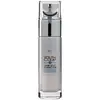What's inside
What's inside
 Key Ingredients
Key Ingredients

 Benefits
Benefits

 Concerns
Concerns

 Ingredients Side-by-side
Ingredients Side-by-side

Water
Skin ConditioningGlycerin
HumectantButylene Glycol
HumectantDimethicone
EmollientNiacinamide
SmoothingC12-15 Alkyl Benzoate
AntimicrobialAlcohol Denat.
AntimicrobialAscorbyl Glucoside
AntioxidantHydroxyethylpiperazine Ethane Sulfonic Acid
BufferingC13-14 Isoparaffin
EmollientPEG-100 Stearate
Stearic Acid
CleansingPotassium Hydroxide
BufferingGlyceryl Stearate
EmollientTriethanolamine
BufferingSodium Citrate
BufferingSodium Hyaluronate
HumectantPalmitic Acid
EmollientAdenosine
Skin ConditioningDisodium EDTA
Laureth-7
EmulsifyingXanthan Gum
EmulsifyingOxothiazolidinecarboxylic Acid
Skin ConditioningCastanea Sativa Seed Extract
Skin ConditioningEthylhexyl Hydroxystearate
EmollientPolyacrylamide
Cetyl Alcohol
EmollientTocopheryl Acetate
AntioxidantPhenoxyethanol
PreservativeCI 77163
Cosmetic ColorantLimonene
PerfumingParfum
MaskingWater, Glycerin, Butylene Glycol, Dimethicone, Niacinamide, C12-15 Alkyl Benzoate, Alcohol Denat., Ascorbyl Glucoside, Hydroxyethylpiperazine Ethane Sulfonic Acid, C13-14 Isoparaffin, PEG-100 Stearate, Stearic Acid, Potassium Hydroxide, Glyceryl Stearate, Triethanolamine, Sodium Citrate, Sodium Hyaluronate, Palmitic Acid, Adenosine, Disodium EDTA, Laureth-7, Xanthan Gum, Oxothiazolidinecarboxylic Acid, Castanea Sativa Seed Extract, Ethylhexyl Hydroxystearate, Polyacrylamide, Cetyl Alcohol, Tocopheryl Acetate, Phenoxyethanol, CI 77163, Limonene, Parfum
Water
Skin ConditioningPrunus Amygdalus Dulcis Oil
Skin ConditioningCaprylic/Capric Triglyceride
MaskingStearic Acid
CleansingPEG-12 Glyceryl Dimyristate
Skin ConditioningGlyceryl Stearate
EmollientPEG-100 Stearate
Silica
AbrasiveTocopheryl Acetate
AntioxidantCetyl Alcohol
EmollientPhenoxyethanol
PreservativeTriethanolamine
BufferingCarbomer
Emulsion StabilisingPanthenol
Skin ConditioningEthoxydiglycol
HumectantPolyaminopropyl Biguanide
PreservativeDisodium EDTA
PPG-12/Smdi Copolymer
EmollientKinetin
Skin ConditioningZeatin
Skin ConditioningPolyurethane-40
Ethylhexylglycerin
Skin ConditioningCitrus Aurantium Dulcis Peel Oil
MaskingCaprylyl Glycol
EmollientSodium Carboxymethyl Betaglucan
Tetrahexyldecyl Ascorbate
AntioxidantAcetyl Octapeptide-3
HumectantImidazolidinyl Urea
PreservativeSodium Hyaluronate
HumectantCamellia Sinensis Leaf Extract
AntimicrobialHydrochloric Acid
BufferingWater, Prunus Amygdalus Dulcis Oil, Caprylic/Capric Triglyceride, Stearic Acid, PEG-12 Glyceryl Dimyristate, Glyceryl Stearate, PEG-100 Stearate, Silica, Tocopheryl Acetate, Cetyl Alcohol, Phenoxyethanol, Triethanolamine, Carbomer, Panthenol, Ethoxydiglycol, Polyaminopropyl Biguanide, Disodium EDTA, PPG-12/Smdi Copolymer, Kinetin, Zeatin, Polyurethane-40, Ethylhexylglycerin, Citrus Aurantium Dulcis Peel Oil, Caprylyl Glycol, Sodium Carboxymethyl Betaglucan, Tetrahexyldecyl Ascorbate, Acetyl Octapeptide-3, Imidazolidinyl Urea, Sodium Hyaluronate, Camellia Sinensis Leaf Extract, Hydrochloric Acid
Ingredients Explained
These ingredients are found in both products.
Ingredients higher up in an ingredient list are typically present in a larger amount.
Cetyl Alcohol is a fatty alcohol. Fatty Alcohols are most often used as an emollient or to thicken a product.
Its main roles are:
Though it has "alcohol" in the name, it is not related to denatured alcohol or ethyl alcohol.
The FDA allows products labeled "alcohol-free" to have fatty alcohols.
Learn more about Cetyl AlcoholDisodium EDTA plays a role in making products more stable by aiding other preservatives.
It is a chelating agent, meaning it neutralizes metal ions that may be found in a product.
Disodium EDTA is a salt of edetic acid and is found to be safe in cosmetic ingredients.
Learn more about Disodium EDTAGlyceryl Stearate is a mix of glycerin and stearic acid.
It is used to stabilize the mixing of water and oil ingredients. By preventing these ingredients from separating, it can help elongate shelf life. It can also help thicken the product's texture.
As an emollient, it helps soften skin and supports barrier-replenishing ingredients.
In cosmetics, Glyceryl Stearate is often made from vegetable oils or synthetically produced.
This ingredient may not be fungal-acne safe
Fun fact: The human body also creates Glyceryl Stearate naturally.
Learn more about Glyceryl StearatePeg-100 Stearate is an emollient and emulsifier. As an emollient, it helps keep skin soft by trapping moisture in. On the other hand, emulsifiers help prevent oil and water from separating in a product.
PEGS are a hydrophilic polyether compound . There are 100 ethylene oxide monomers in Peg-100 Stearate. Peg-100 Stearate is polyethylene glycol ester of stearic acid.
Phenoxyethanol is a preservative that has germicide, antimicrobial, and aromatic properties. Studies show that phenoxyethanol can prevent microbial growth. By itself, it has a scent that is similar to that of a rose.
It's often used in formulations along with Caprylyl Glycol to preserve the shelf life of products.
Sodium Hyaluronate is hyaluronic acid's salt form. It is commonly derived from the sodium salt of hyaluronic acid.
Like hyaluronic acid, it is great at holding water and acts as a humectant. This makes it a great skin hydrating ingredient.
Sodium Hyaluronate is naturally occurring in our bodies and is mostly found in eye fluid and joints.
These are some other common types of Hyaluronic Acid:
Learn more about Sodium HyaluronateStearic Acid is a fatty acid. It is an emollient, emulsifier, and texture enhancer.
As an emollient, stearic acid helps soften skin. It aids the skin's protective barrier by preventing water loss. It also provides a gentle cleansing effect without stripping away natural oils.
Stearic acid may also be used to enhance the texture of products. It can add volume and stabilize ingredients such as water and oil. This can help water and oil ingredients from separating.
Sources of stearic acid include animal or vegetable fats/oils such as coconut or shea. It can be naturally found in butter, cocoa butter, shea butter, vegetable fats, and animal tallow.
This ingredient may not be Malassezia folliculitis, or fungal-acne safe.
Learn more about Stearic AcidTocopheryl Acetate is AKA Vitamin E. It is an antioxidant and protects your skin from free radicals. Free radicals damage the skin by breaking down collagen.
One study found using Tocopheryl Acetate with Vitamin C decreased the number of sunburned cells.
Tocopheryl Acetate is commonly found in both skincare and dietary supplements.
Learn more about Tocopheryl AcetateTriethanolamine is an emulsifier and pH adjuster. It is created using ethylene oxide and ammonia. This gives Triethanolamine a nitrogen core and a similar scent to ammonia.
As an emulsifier, it prevents ingredients from separating and enhances texture by adding volume to a product.
PH adjusters are common in cosmetic products. The pH of a product can affect the effectiveness of other ingredients. A product with a high pH may also irritate the skin.
Learn more about TriethanolamineWater. It's the most common cosmetic ingredient of all. You'll usually see it at the top of ingredient lists, meaning that it makes up the largest part of the product.
So why is it so popular? Water most often acts as a solvent - this means that it helps dissolve other ingredients into the formulation.
You'll also recognize water as that liquid we all need to stay alive. If you see this, drink a glass of water. Stay hydrated!
Learn more about Water